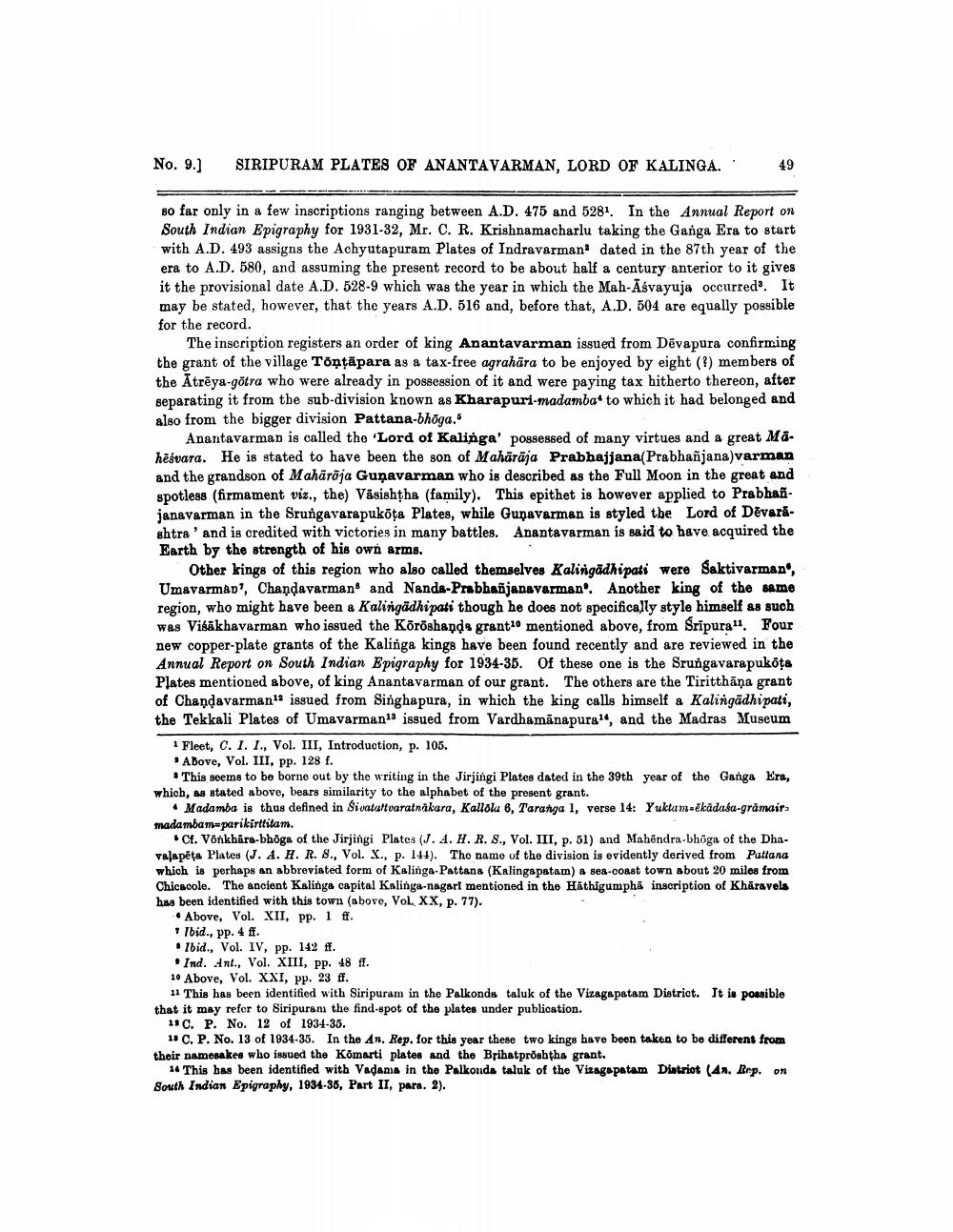________________
No. 9.]
SIRIPURAM PLATES OF ANANTAVARMAN, LORD OF KALINGA.
49
so far only in a few inscriptions ranging between A.D. 475 and 5281. In the Annual Report on South Indian Epigraphy for 1931-32, Mr. C. R. Krishnamacharlu taking the Ganga Era to start with A.D. 493 assigns the Achyutapuram Plates of Indravarman' dated in the 87th year of the era to A.D. 580, and assuming the present record to be about half a century anterior to it gives it the provisional date A.D. 528-9 which was the year in which the Mah-Asvayuja occurred. It may be stated, however, that the years A.D. 516 and, before that, A.D. 504 are equally possible for the record.
The inscription registers an order of king Anantavarman issued from Dēvapura confirming the grant of the village Tõnţāpara as a tax-free agrahāra to be enjoyed by eight (?) members of the Ātrēya-gotra who were already in possession of it and were paying tax hitherto thereon, after separating it from the sub-division known as Kharapuri-madambat to which it had belonged and also from the bigger division Pattana-bhöga.
Anantavarman is called the 'Lord of Kalinga' possessed of many virtues and a great Ma. hēšvara. He is stated to have been the son of Mahārāja Prabhajjana(Prabhañjana)varman and the grandson of Mahārāja Gunavarman who is described as the Full Moon in the great and spotless (firmament viz., the) Väsishtha (family). This epithet is however applied to Prabhanjanavarman in the Srungavarapuköţa Plates, while Gunavarman is styled the Lord of Dēvarashtra' and is credited with victories in many battles. Anantavarman is said to have acquired the Earth by the strength of his own arms.
Other kings of this region who also called themselves Kalingadhipati were Saktivarman, Umavarman', Chandavarman and Nanda-Prabhañjanavarman'. Another king of the same region, who might have been a Kalingadhipati though he does not specifically style himself as such was Vilākhavarman who issued the Köröshands grant10 mentioned above, from Sripura". Four new copper-plate grants of the Kalinga kings have been found recently and are reviewed in the Annual Report on South Indian Epigraphy for 1934-35. Of these one is the Srungavarapukota Plates mentioned above, of king Anantavarman of our grant. The others are the Tiritthāņa grant of Chandavarman12 issued from Singhapura, in which the king calls himself a Kalingādhipati, the Tekkali Plates of Umavarmanı issued from Vardhamanapura", and the Madras Museum
1 Fleet, C. 1. I., Vol. III, Introduction, p. 105. - Above, Vol. III, pp. 128 f.
* This seems to be borne out by the writing in the Jirjingi Plates dated in the 39th year of the Ganga Era, which, as stated above, bears similarity to the alphabet of the present grant.
• Madamba is thus defined in Sivataltvaratnakara, Kallolu 6, Taranga 1, verse 14: Yuklam=ēkādaśa-grāmaira madambam=parikirttitam.
Cf. Vonkhāra-bhöga of the Jirjingi Plates (J. 4. H. R. S., Vol. III, p. 51) and Mahendra-bhöga of the DhaValapēta Plates (J. A. H. R. 8., Vol. X., p. 146). Tho name of the division is evidently derived from Pattana which is perhaps an abbreviated form of Kalinga-Pattana (Kalinga patam) a sea-coast town about 20 miles from Chicacole. The ancient Kalinga capital Kalinga-nagari mentioned in the Hathigumph. inscription of Khāravels has been identified with this town (above, Vol. XX, p. 77).
• Above, Vol. XII, pp. 1 ff. * Ibid., pp. 4 ff. . Ibid., Vol. IV, pp. 142 ff.
Ind. Ant., Vol. XIII, pp. 48 ff. 10 Above, Vol. XXI, pp. 23 ff.
11 This has been identified with Siripuram in the Palkonda taluk of the Vizagapatam District. It is possible that it may refer to Siripuram the find-spot of the plates under publication.
11 C. P. No. 12 of 1934-35.
11 C, P. No. 13 of 1934-35. In the An. Rep. for this year these two kings have been taken to be different from their namesakes who issued the Komarti plates and the Brihatproshtha grant.
14 This has been identified with Vadama in the Palkonda taluk of the Vizagapatam Distriot (4n. Erp. on South Indian Epigraphy, 1934-36, Part II, para. 2).




